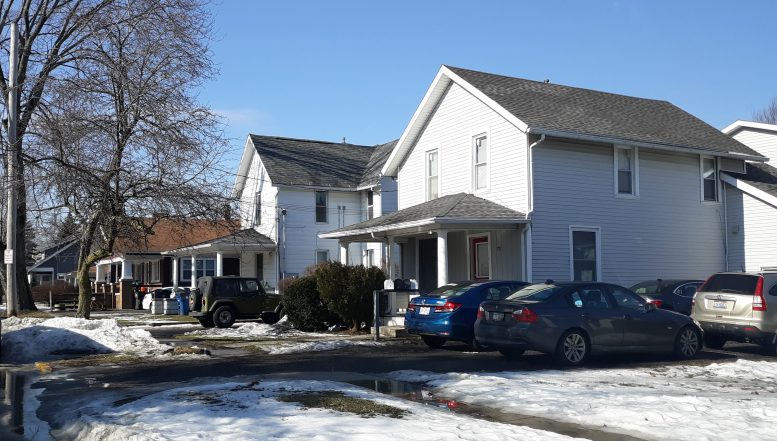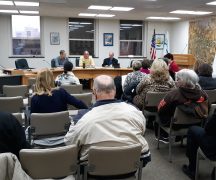By JAN LARSON McLAUGHLIN
BG Independent News
Every year, as Bowling Green State University students move back to their temporary homes, permanent city residents talk with them about being good neighbors. That includes not packing rental units with more people than allowed.
The East Side Neighborhood Association goes door-to-door in the residential areas near campus, distributing “welcome back” flyers. In the past, those flyers included information about the city’s occupancy ordinance.
But earlier this year, a federal court ruled against the city’s ordinance that restricted the number of unrelated people who can live in a rental property.
The city has used the ordinance for decades to limit the number of people living in rental units to three people – unless they are related.
But the ruling, issued by Federal Judge James R. Knepp, states that the number of people allowed in a home should be determined by the number of bedrooms – not by the city’s desire to limit density in single-family neighborhoods.
The ruling is a victory for at least 23 landlords in Bowling Green who reportedly own more than 161 homes that could not be rented out to more than three unrelated people – even though the homes have four or more bedrooms and ample parking.
But the ruling left East Side city residents in limbo – not knowing the new residency rules. So on Monday, the neighborhood group, led by Rose Hess, sent a letter to City Council asking for clarification before they distribute the flyers to nearly 500 single-family homes rented out to students.
“In the past we have always given students information about the occupancy ordinance. In the absence of a written law we have nothing to tell them this year,” the letter from East Siders stated.
The citizens group was under the impression that council would pass a new ordinance by summer reflecting the court decision. While the new rule will be one resident per bedroom – there are exceptions.
“We have heard that one-bedroom houses will be excluded and can have two, and that two-bedroom houses will be excluded and can have three persons, but three- and four-bedroom houses will be limited to what the judge ordered,” the letter stated. “This is likewise arbitrary and could be a slippery slope if those living in a three- or four-bedroom house challenge the exceptions that one- and two-bedroom houses have.”
The East Side group also questioned how the new regulations will be enforced.
“Is it complaint basis or will the city be actively pursuing violators? What are the penalties,” the citizens asked.
According to the East Side organization, the court’s ruling can actually benefit the city.
“Judge Knepp gave us a gift; the opportunity to reduce density in our neighborhoods where there are many rentals. That should be our goal. We need an ordinance reflecting Judge Knepp’s decision,” the group wrote in its letter.
In his response to the East Side letter, City Attorney Mike Marsh explained that he and the city planning director had planned to go through one year under the new court ruling before recommending changes to the zoning code.
Marsh’s opinion is that one-bedroom and two-bedroom homes would still be permitted up to three unrelated people residing in them, and properties of three bedrooms and more are limited to one person per bedroom per the court order.
“This court decision has already been helpful to us as we deal with properties from time to time,” Marsh stated in his letter. “Specifically, the limitation has allowed us to decrease the number of occupants voluntarily with a couple of landlords, one of whom was a plaintiff in the lawsuit, for this coming fall occupancy.”
Marsh predicted the federal court decision will end up being a net plus for the city as it works to handle occupancy, especially in the first and second wards.
Also at the council meeting, Parks and Recreation Director Kristin Otley asked that if residents see dogs running off leash in any of the city parks, that they report it to a park staff person or even call the police.
Since there is a city ordinance requiring dogs to be leashed in the parks, the owners can be cited if they allow their pets to run free, Otley said.
Council member Greg Robinette asked council members to come up with ideas of how to generate more business for downtown stores that have been hurt by the prolonged construction.
“I just challenge all of us to put on our thinking caps,” of how to energize the community to shop downtown, he said.
In other business at Monday’s meeting:
- Public hearings were set for Oct 7, at 6:30 p.m., for a zoning amendment regarding off-street parking, and a zoning change at 1019 Mourning Dove Lane and 936 Robinwood Lane.
- Mayor Dick Edwards extended best wishes to Bowling Green City Schools, which starts the new year on Wednesday.
- Edwards reported he will walk through neighborhoods near BGSU with BGSU President Rodney Rogers on Friday, to welcome new students and encourage them to work on being good neighbors to the rest of the community.
- Public Utilities Director Brian O’Connell reported that several power outages occurred in the city early Sunday morning due to lighting strikes to transformers and tree limbs falling on power lines.
- Municipal Administrator Lori Tretter reminded council that Mercer Road will be closed Thursday as students move in at BGSU.
- Council President Mike Aspacher asked that an update on the creation of a city sustainability board be reported to council on Sept. 3, at 6 p.m.
- Public Works Director Brian Craft reminded that paving of the roundabouts on East Wooster at the Interstate 75 interchange will require them to be closed overnight on Thursday and Friday.
- Craft reported on downtown paving, saying that temporary striping will be done soon, and all lanes plus parking will be open soon.



